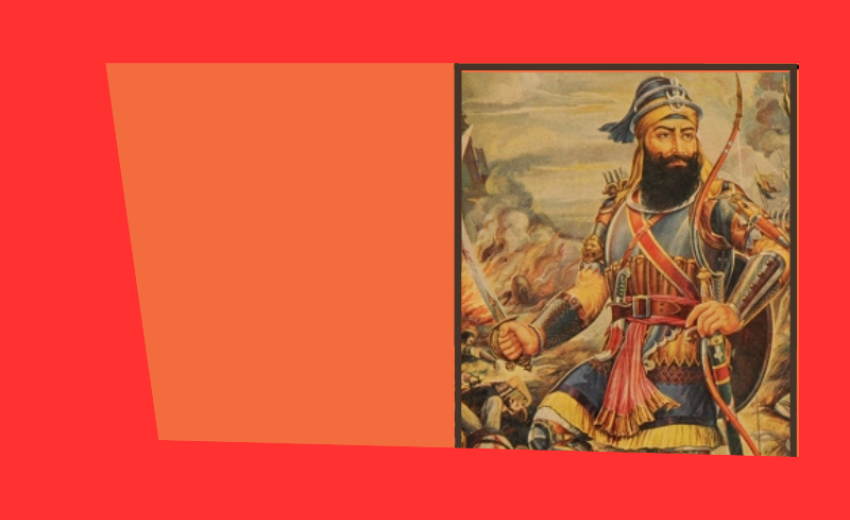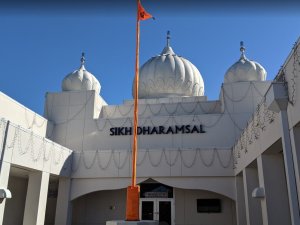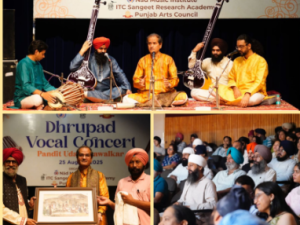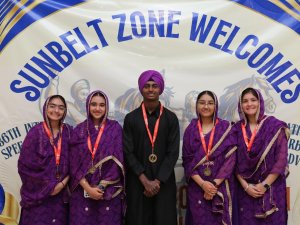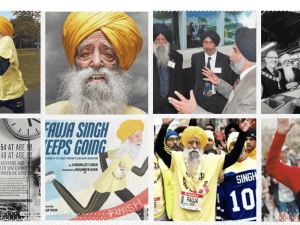Baba Banda Singh Bahadur (1670 – 1716)
The 18th Century Khalsa warrior Banda Singh Bahadar (Bahadur) is credited with breaking centuries of Mughal tyranny and oppression. A brilliant military strategist, he wrested the territories of Punjab from the Imperial army defying overwhelming odds. What he accomplished in a few short years laid the foundation for those who would follow after. His achievements in battle awed, and struck fear in his adversaries, and revered him as a legendary champion by those he liberated from the atrocities of a cruel regime.
Transformative Years
Banda Singh Bahadar went through a series of personal transformations and name changes before he came to be known throughout the land by his military conquests as the warrior Banda Singh.
Lachhman Dev
- Birth 1670 – Born at Rajouri in Jammu District of Kashmir, Banda Singh, son of the ploughman Ram Dev Sodhi received the name Lachhman Dev, at birth which occurred during the month of Kartik on Sudi the 13th day of the waxing moon, Samvat 1727, Bikrami (Bk) calendar, or the 16th of October 1670 C.E., and 27th of October 1670, A.D.
- Early Life 1671-1684 – His mother being the eldest daughter without brothers, Lachhman Dev inherited his maternal grandfather’s land in Buttana, where his family took up residence after his grandfather’s death. His family often gave food and shelter to wandering holy mystics who happened by. The young lad trained with a retired soldier, Salim Khan, who taught him to excel at archery and use of other weaponry, riding horses, and wrestling.
- Departure 1685 – At age 15, while hunting, Lachhman shot a doe with his bow. As he cut open her belly to remove her entrails, he observed that she had carried two unborn fawns, and watched in dismay as they struggled for life, gasping and shuddering in their death throes. A great melancholy came over the boy. He could not settle his mind, so took leave from his home and parents to seek penance.
Madho Das
- Baragi 1686 – Lachhman wandered about until he met the renunciate Janaki Prasad and became a follower of the Bairagi Raam Das at the shrine of Ram Thamman nearby Kasur. Abandoning his former life altogether, the boy took the name Madho Das. He traveled aimlessly about until he met, the esthetic Yogi Aughar Nath in the Panchvati woods nearby Nasik of Maharashtra. He settled there for about 5 years as a disciple, until his master’s death. During those years Madho immersed himself in meditation, and fervently practiced yoga, By age 21 he had attained proficiency in mystic abilities.
- Master 1691 – Madho shifted to the River Godavari at Nanded and set up a hermitage where he trained disciples in his continued practices of yoga and meditation. He remained Master of his hermitage for about 16 years, until age 38. As his mystic abilities increased, so did his fame, and his pride in his achievements, until he believed himself to be superior to all others.
Gur Bakhs Singh
- Khalsa Initiate 1708 (September 3) – While in Nanded, Guru Gobind Singh paid a visit to Madho Das at his hermitage, but found him gone. While he waited for the mystic master, he sat upon a seat that Madho kept for his own use only. When Madho returned and found his seat occupied by the Guru, he attempted to overturn it using the siddhi powers he had perfected, but nothing at all happened. Guru ji remained sitting and greeted Madho graciously and asked him, “Are you the one I have come to see? Do you know of me?” Madho recognized that the measure of the Guru’s humility far surpassed that of his own pride. Realizing that he had met his own master, he knelt before him saying, “You are my Guru. I am your bond servant Banda, please instruct me.” Guru Ji spoke with him at length about the atrocities of Mughal tyranny and urged Madho to become his Khalsa warrior. Guru Gobind Singh brought Madho to his camp and arranged for his initiation. Madho received a new name befitting a Khalsa warrior, Gur Bakhs Singh “Endowed by the Guru” The Guru then endowed his Banda with his own sword and bow, and five of his own arrows. He also gave his Banda a Nishan Sahib flag, and a drum to carry into battle, thereby making his Banda his Commander in Chief. Guru ji then appointed five Singhs to be the generals of his Banda’s army:
- Baj Singh
- Binod Singh
- Daya Singh
- Kahan Singh
- Raam Singh
- Commander 1708 (November 7) – An attempt to assassinate Guru Gobind Singh a few weeks earlier, had left him with a serious injury. He felt that he had improved and rose from his bed to string his bow. As he drew the bow his wound re-opened, blood poured forth profusely, and it became apparent that there would be no recovery. He named the Guru Granth Sahib his everlasting successor, and named his Banda, Gur Bakhs Singh, to be the supreme commander of the Khalsa and charged him with routing out Mughal tyranny.
Banda Singh Bahadar Chastiser of the Imperial Regime
Banda Singh began a strategic campaign to punish the perpetrators responsible for the deaths of the Late Guru Gobind Singh, his father, mother, and sons, and drive out the tyrannical Mughal rulers from Punjab and Northern India. He established a Khalsa Raj and issued coins featuring the names of Guru Nanak and Guru Gobind Singh with the words Degh, signifying the kettle of charity, and Tegh signifying the sword of victory. His major conquests, which dealt heavy blows to the Mughal Regime, redefined his country in seven short years.
1709:
- Battle of Sonipat – The first significant battle fought by Banda Singh Bahadar with Mughal Empire included commanders Baj Singh and Binod Singh. The Sikh Army of 500 soldiers camped at Khanda village two miles from Kharkhoda, and marched seven miles to Sonipat District of Haryana to surprise, and overthrow, the oppressive Mughal administration.
- Battle of Samana (November 26) – Banda Singh headed towards Samana of Patalia District home to the executioner Sayyed Jalal-ud-din who had beheaded Guru Teg Bahadar, and also to Shashal Beg and Bashal Beg, the executioners who beheaded Guru Gobind Singh’s two younger sons, the Sahibzadas Zarowar Singh, age 9, and Sahibzada Fateh Singh, age 6. Banda Singh Bahadar led 3,000 horse soldiers along with 5,000-foot soldiers through the night. They reached and breached the gates in the early dawn. The inhabitants surrounding the city joined the Sikh army to overthrow and punish their oppressors. After taking Samana, the army continued towards Sirhind conquering Ambala, as well as the towns of Kunjpura, Ghuram, and then Thaska, occupied by Rhanghars who had terrorized the local populace with their atrocious cruelties.
- Battle of Kapuri – Banda Bahadar also captured Shahabad, and Mustafabad. He then learned about the tyrannical persecution of Sikhs and Hindus, the despicable kidnapping of Hindu brides, and the depraved debaucheries carried out by Qadam-ud-din, in nearby Kapuri. Upon arrival, the Sikh army burnt down the fortress at Kapuri, where they slew Qadam-ud-din, and set free the captives.
1710:
- Battle of Sadhaura – Banda Singh Bahadar along with Baj Singh, Binod Singh, and Baba Deep Singh, engaged the Mughal Sayyid and Sheikh forces in Sadhaura, where they captured and razed the fortress of the Mughal stronghold. They soundly defeated Osman Khan who had tortured, and then murdered the Muslim Saint, Pir Budhu Shah, (also known as Syed Badruddin Shah), because he had once given aid to Guru Gobind Singh in the battle of Bhagnani. Outraged at the gross mistreatment of the Hindu populace who had been prevented from cremating their deceased, and whose sacred cattle had been slaughtered on their doorsteps, the locals joined with the Sikhs to capture, punish, and hang Osman Shah, and drive out his elitist cronies who had taken over the late Pir’s abode.
- Battle of Ropar May – The governor, Wazir Khan of Sirhind, learned the Sikhs whereabouts and sent Sher Mohammad Khal, Khizar Khan, Nashtar Khan, and Wali Mohammed Khan, with a large force of mounted soldiers to accost Banda Singh Bahadar and his small contingent of warriors. A dust storm interrupted the fighting. The next morning Sikh reinforcements arrived. Khizar Khan received a bullet wound to his head. Nashtar, and Wali Mohammad Khan, also died while attempting to recover the body. Sher Mohammad Khan received grave wounds as well. Fearing impending death, he retreated, and fled, to Sirhind, followed by his army.
- Battle of Chappar Chiri (May 12) – As Banda Singh Bahadar, his army and their reinforcements, proceeded towards Sirhind, Hill Chiefs, hoping to punish the Mughals, paid mercenaries to support the Sikhs. Hindu Jat, Gujar, and Rajput thugs, and other professional plunderers, also joined the ranks of the Sikhs army with an objective purely to pillage Sirhind. Wazir Khan met them just about 10 miles outside of Sirhind. Wazir Kahn plotted a subterfuge with his associate Sucha Nand, to send the latter’s nephew with 1000 men to join, and undermine, the Sikh army. The intrigue failed however, due to intimidation by the superior fighting forces of Wazir Khan’s 20,000 which included artillery, elephants and professional fighters. Sucha Nand’s nephew and his men, as well as many of the hangers on, fled the onslaught. Banda Singh accompanied by Baj Singh, Binod Singh, and Bhai Fateh Singh, led a ferocious charge into the midst of the battle. Sher Muhammad Khand, Khwaja Ali of Malerkolta, and Wazir Khan himself, all lost their lives along with many of their fighters. The remaining Mughal soldiers retreated to Sirhind.
- Siege of Sirhind (May 12) – Banda Singh Bahadar, accompanied by Fateh Singh, Baj Singh and the Sikh army marched on to Sirhind. The gates had been shut, and gunfire poured steadily from the fortress walls.
- (May 13) – Banda Singh suffered the loss of 500 men. His army retaliated with relentless pressure until they managed to break through the gates.
- (May 14) – Banda Singh Bahadar and his army captured, and executed, Sucha Nand and others who had supported and participated in his tyranny. Banda Singh assigned Baj Singh, assisted by Ali Singh, to govern Sirhind. They set up a new administration, appointed new officials, struck coins, abolished serfdom, and divided up feudal lands among local farmers.
- Battle of Saharanpur (July) – Sikh forces led by Banda Singh Bahadur engaged Jalal Khan, and Ali Hamid Khan who had been harassing Sikh converts. Fear of Sikh forces resulted in little opposition. The Sikhs sent a letter to Shamas Khan the ruler of Jalandhar demanding his surrender. Soon after, Muslims began a Jihad and gathered by the thousands in an attempt to quell the Sikh uprising. Meanwhile Banda Singh also conqured Behat, Sarsawa, and Ambeyta
- (July 11) Banda Singh reached Nanauta where Gujjars, who referred to themselves and Nanakpanthis, joined his army. Banda Singh also gained control of Batala, and Kalanaur, where about 5,000 sympathetic Muslim’s also joined his forces. He then marched towards Lahore, leaving a contingent behind to occupy Pathankot.
- Battle of Jalalabad (July) – Banda Singh Bahadar learned about the oppressive and tyrannical treatment of Sikhs and Hindus by Afghan ruler Jalal Khan Rohilla. Banda Singh sent emissaries to bargain for better treatment of non-Muslims, but in reply they received only ridicule. Jalal Khan and Sayyid Taj-ud-Din Barha began preparations to defend their holdings. The Mughal army under command of Jalal Khan’s nephew Hazbar Khan, and his brother-in-law, Ghulam Mohammad Khan Banira, met Banda Singh between Nanauta and Jalalabad with 6,000 archers and foot soldiers, as well as a calvary of 6,000 mounted soldiers. Jalal Khan's nephews Jamal Khan, Pir Khan, and Hazbar Khan, all lost their lives in a bloody battle with the Sikhs that lasted four days. The Mughal army fell back to Jalalabad, where they entrenched with Jalal Khan, while the Sikh army besieged the city.
- (August) For 20 days the Sikhs endeavored to breach the walls of Jalalabad. They surrounded the city with cannons, and attempted to burn the gates, however bad weather, flooding, and urgency in other territories, demanded their immediate attention and they abandoned their siege of Jalalabad. Banda Singh Bahadar left with an army consisting of 70 to 80 thousand soldiers to confront reinforcements that had sent by Mughal Emperor Bahadur Shah in an attempt at recovering territories which had been lost to Sikhs.
- Siege of Kotla Begum (September) – The Muslims of Lahore declared a Jihad to rout out the Sikhs and flew the green flag of Islam. Some Sikhs took quarters in Bharatpur, where the Mughals attacked them. After a great deal of prolonged fighting, the Sikhs long gained enough ground to escape. The Jihadists then learned that 700 Sikhs occupied the fort at Kotla Begum and began a siege led by Mir Mohammad, Attaullah Khan, Mohabbat Khan, Murtaza Khan, Pahar Mal, Haji Babar Beg, Mir Inayat Ali, Pir Mohammad, and Mirza Naki. The Sikhs fought ferociously, engaging the Jihadis in hand-to-hand combat with swords. Cutting down hordes of their enemy, the Sikhs prevailed. The Mughals retreated leaving behind a good deal of their fighting equipment with which the Sikhs outfitted themselves.
- Battle of Bhilowal (October) – After tending their wounded, the Sikhs amassed an army of 20,000 and caught up with the army of 50,000 Mughals in Bhilowal where they captured their horses and bested them again. Having used up all of their bullets, the Sikhs fought with their kirpans. Massive Mughal casualties ensued. Many of the major leaders lost their lives in this battle. Attaullah Khan called out to his men to flee for their lives lest they die. Many perished because of impaired vision, and from broken necks, as they smashed their heads into trees, armaments, and whatever lay in their way, during their wild retreat. Banda Singh also gained control of Majha and Riarki.
- Battle of Rahon (October 3 -11) – Banda Singh Bahadar had taken control of nearly half of Eastern Punjab from River Indus to River Satluj. Sikhs began arming themselves and appointing their own local administrators. They collectively sent a letter to Shamas Khan demanding that he submit to their authority and turn over his treasury. Shamas hatched a plot to placate the Sikh with a show of compliance by sending a modest tribute. Meanwhile he moved his army towards Rohan. Upon learning of the deception, the Sikhs made preparations for battle, called for reinforcements, quickly raised a fortress, and collected revenue in Rahon. The Khan’s army of 100,000 surrounded and laid siege to the fort attacking from all sides. The Sikhs retorted with cannon fire. Outnumbered, the Sikhs used guerilla tactics to fight under cover of darkness attempting to even the odds. Realizing the futility of their endeavor, the Sikhs slipped away hoping to convince the Khan they had given up. After a short pursuit, Shamas contented himself with capturing the fort and any revenue left behind. He then broke camp and left a small contingent to guard the fort. After the Khan had departed for Sultanpur, a thousand Sikhs attacked and took back the fort. Celebrating their victory, the Sikhs established a revenue system which gave back two thirds of tribute to the locals. The Sikhs moved on to take Jalandhar and Hoshiarpur.
- Battle of Thanesar (Nov 13) – Banda Singh sent an army, under the command of Binod Singh and Ram Singh, to engage Firuz Khan Mewati. The opposition turned out to be greater than supposed as it had had received reinforcements led by Sayyid Wajih-ud-din Khan Bara. The Sikhs suffered in all, four defeats. The Mughals took prisoners, beheaded them, and loaded up carts with 300 Sikh heads, and also hung the heads of Sikhs on tree limbs, tied by their long hair.
- Siege of Lohgarh (December 5 through 16) – An army led by Mirza Muhammad Mu’zaam also known Bahadur Shah I, his third son Mirza Rafi ush-Shan also known as Rafi-ul-Qdar, and other Mughal nobles advanced towards Lohghar fort occupied with Sikhs led by Banda Singh Bahadar. Stories of Banda’s supernatural abilities in battle spread throughout the Mughal forces disheartening those who believed him to be a sorcerer.
- (December 5) – Commanders Rustamdil Khan and Firoze Khan Mewati led a scouting party towards the fort Mughal hoping to assess Banda Singh’s defense positions. A surprise attack by the Sikhs resulted in mayhem. The Mughal army sustained heavy casualties, including the wounding of Firoze Khan Mewati's son and the death of his nephew. The Mughal army scattered under relentless pounding by the Sikh army, who themselves sustained a loss of 1,500. Rafi ush-Shan sent reinforcements to Rustamdil who regrouped his men and pushed on towards the fort.
- (December 10) – Bahadur Shah issued an order to his commanders to exterminate all followers of Nanak. Even so Banda Singh Bahadar guaranteed Muslims, and Hindus, who had joined forces with him, the right to worship according to their own conscience. Commanding an army of about 60,000 horsemen, Rafi ush-Shan surrounded the fort which sat atop a hill. He along with Raja Udet Singh Bundela of took up positions to the left. Grand Vizer Mumin Khan II (Jumat-ul-Mulk Khan-i-Khanan), his sons Mahabat Khan, Khan Zaman, and Raja Chatarsal Bundela with Islam Khan Mir Atish, Hamid-ud-din, Azim-us-Shan, and Jahan Shah commanding positions to the right of the fort. Rustamdil took the center most position. The Imperial army also had large numbers of mercenaries, among them both Rohill Afghan, and Baloch, plunderers hoping to profit from pillaging. Heavy fighting commenced at the bottom of the hill, with an immense loss of life including a son of Sucha Nand. The Sikhs raced up the hill to take shelter in the fort. Outnumbered, and without any food, the Sikhs suffered deprivation along with death due to starvation. They took a decision and made a plan. A Sikh new convert, Gulab Singh, offered to masquerade as Banda Singh. At dawn Banda Singh led a party of survivors out of the fort under heavy fire.
- (December 12) – The Mughals realized that Banda Singh Bahadar has made good his escape.
- (December 16) – The Mughals completed their capture of the Lohghar Fortress and took Gulab prisoner along with any other Sikh survivors who remained with him, as well as any locals who had taken refuge in the fort.
1711:
- Invasion of the Hill States – Having wrested Punjab from the Mughals Banda Singh Bahadur turned his efforts towards the Hill States commanded by Rajput forces:
- Khalur – Battle of Bilaspur: Raja Ajmer Chand of Khalur had been a major adversary of Guru Gobind Singh. Banda Singh attempted negotiations, however the Raja resisted with an army of 1,300 soldiers and seven war elephants. Banda Singh sent a contingent of volunteers commanded by five Singhs. Kehar Singh, Ranjit Singh and Ranjor Singh, dispatched all seven elephants. Bajar Singh approached the fort and took out its gates. Baghar Singh cut through the remaining fortress defenses blocking the entrance. Reinforcements arrived and completed the victory which greatly terrorized the other hill Rajas most of whom surrendered without resistance.
- Mandi – The Raja of Mandi professed himself to be an admirer of Guru Nanak and offered a girl for marriage from his own family.
- Kullu – Banda Singh wished to visit the shrine of Mahesh and its inhabitants, however the Raja of Kullu had him detained. The Sikhs, aided by Sudh Sain, freed him and punished the Raja.
- Chamba – Raja Udai Singh had his royal minister offer a treaty stipulating a tribute to be paid to Banda Singh Bahadar which he graciously accepted along with his blessings.
- Banda Singh Weds Susheel Kaur – It is from these Hill States that Banda Singh’s bride Bibi Susheel Kaur came. She is believed most likely to have been the daughter of either the Raja of Mandi or the Raja Udai Singh. Her family had been devotees of Guru Nanak for several generations. Bibi ji received Amrit from the Panj Pyare who approved her marriage to Banda Singh. She also trained with the Khalsa warriors and accompanied her husband in battle wherever his conquests led.
1712
- Battle of Jammu (January 22) – Banda Singh Bahadar and his army of Sikhs finally succeeded in killing Shamas Khan and Bayazid Khan nearby Bahranpur. The Sikhs then occupied the townships of Pasrur, and Aurangbad. Rustamdil Khan caught up with them near Pasrur, and with the aid of Muhammad Amin Khan Turani, chased the Sikhs led by Banda Singh Bahadar into the hills of Jammu. Aghar Khan joined with the Mughal forces who attempted to surround the Sikhs. However, the Sikhs managed to break through the Mughal lines and escape. Rustamdil Khan took revenge and raided the villages Paril, and Kathua, where he captured villagers that he believed to be Sikhs, and then sold them in the Lahore slave markets. Muhammad Amin Khan continued to pursue Banda Singh Bahadar and his army and managed to kill 500 Sikh soldiers.
1712 - 1713:
- Recapture of Sadaura & Second Battle of Lohgarh (December) – A civil war broke out between heirs of the deceased Mughal ruler Bahadur Shah I (Shah Alam I) who had died on February 28, of 1712. While the late Shah’s sons Jahandar Shah (Mirza Mu’izz-ud-Din Beh Muhhamand Khand), Farrukh Siyar, and their brothers, vied for succession, Banda Singh Bahadar gained control of both Sadhaura, and Lohghar. Banda Singh stayed in Lohghar for a couple of months while repairing and strengthening the Fort, which the Sikhs used as their capitol for the next couple of years.
1714:
- Battle of Kiri Pathan (March 27) – An extended siege forced the Sikhs to abandon both Sadhaura and Lohghar. Villagers began harassing the Sikhs. Their commanders met up at Kiri Pathan. The Sikhs of Kahnuwan rallied together led by Jagat Singh and attacked the village chief, Uman Ghazi, at Kiri Pathan of Gurdaspur. Heavy casualties included commander Muhammad Is’haq. The Mughal Empire retaliated by sending Nawab Abdul Samad Khan Bahadar along with Zakariya Khan to punish every Sikh they could lay hands on.
1715:
- Battle & Siege of Gurdas Nangal (March) – Farrukh Siyar had overthrown his brother Jahandar Shah, but had little real power, and answered to the Sayyid brothers. He undertook a campaign to lay siege to Gurdaspur.
- (April 1) – Imperial commander Abd al-Samad Khan sought out, and confronted, Banda Singh Bahadar and his roving band of Sikhs, who made for the Fort at Gurdaspur which had been built up to provision 60,000 horses along with stores of fodder and grain. However Imperial commanders surrounded the fort and made it impossible to access. Qamar-ud-din Khan with an army of 20,000 guarded the Eastern approach. Abd al-Samad Khan with an army of 10,000 guarded the Southern approach. Zakariya Khan with an army 5,000 guarded the North. To the West lay River Ravi with all boats guarded by local officials. A Contingent of 750 Sikhs led by Banda Singh Bahadar, Binod Singh, and Hakim Nand, took shelter in walled compound belonging to Duni Chand located at Gurdas Nangal. They dug a moat around the perimeter and used a nearby canal to fill it with water. The Imperial forces also dug trenches on the other side of the moat and so a prolonged battle began.
- (April 17) – Word reached Farrukh Siyar that a siege had begun. Along with reports that bands of 40 to 50 Sikhs would venture out several times daily to gather fodder for the animals. If any enemies approached, the Sikhs would fight them off. Their daring, and fear that Banda Singh Bahadar possessed supernatural abilities, intimidated the Mughal soldiers and commanders who mostly wished that he would escape again. For eight months the Sikhs held out. They had little and often nothing to eat. Over time their animals died. They resorted to consuming carcasses, hides, bones, and bark scraped from trees.
- (December 7) – With the Sikhs so weakened by starvation that they could no longer offer resistance, the Mughals entered the fort. They immediately beheaded about 300 emaciated Sikhs already at the brink of death and searched their bodies for gold. They captured Banda Singh Bahadar, his wife Susheel Kaur, and their son Ajai Singh, along with all the remaining survivors, and transported them to Delhi.
Martyrdom
The Mughals took their captives to Lahore and led them in a procession through the streets of Lahore. They then set out for Delhi.
1716:
- Imprisonment of Banda Singh Bahadar (February 27) – The Mughals arrived in Delhi with a grisly cargo including 740 prisoners confined by heavy chains. They also had with them 700 carts loaded with severed heads, and another 2,000 heads impaled on pikes. Farrukh Siyar ordered that Banda Singh Bahadar, and 41 others be detained in the fort, with the remaining 694 captives to be given to Sarbrah Khan along with orders that 100 Sikhs be executed daily over the next week. Meanwhile Susheel Kaur and Ajai Singh had been placed in Farrukh Siyar’s harem.
- Martyrdom of Banda Singh Bahadar (June 9) – The Mughals took the remaining prisoners to the tomb of Khwaja Qutb uk-Din Bakhtiyar Kakhi nearby the Qutb Minar. There, Banda Singh Bhahadar refused the opportunity to escape death by renouncing his faith and accepting Islam. His captors brought his four-year-old son, Ajai Singh, before his father and brutally dismembered his innocent child, then proceeded to gouge out Banda Singh’s eyes, hack off his hands and feet, and rip pieces of his flesh from his body with red-hot iron grips, before severing each of his arms and legs. All the while, Banda Singh maintained complete composure and never gave his tormentors the satisfaction of emitting a single sound.
- Martyrdom of Susheel Kaur – Susheel Kaur also refused all pressure to renounce her faith, join Islam, and become a wife of Farrukh Siyar, in order to escape death. She heard the report of the martyrdom of her husband and son with absolute equanimity. Her captors threatened her with indignities, rape, and prostitution, should she not submit to Islam. Unarmed, she had no defense, but calmly seized a knife from a table, and with it took her own life, robbing her persecutors of her body.
The Mughal Dynasty never recovered the losses inflicted by Bhanda Singh Bahadar and his Khalsa warriors. His unceasing seven years of onslaught caused their decline and brought about their eventual demise.

